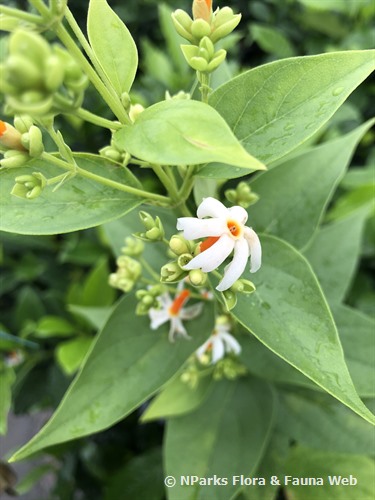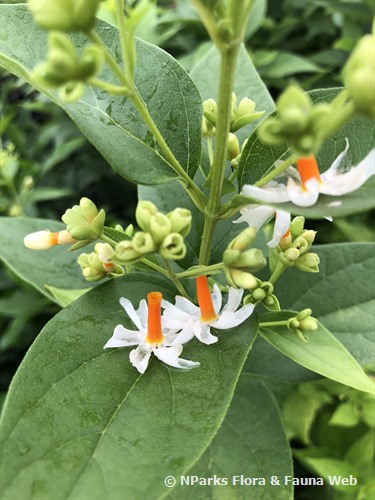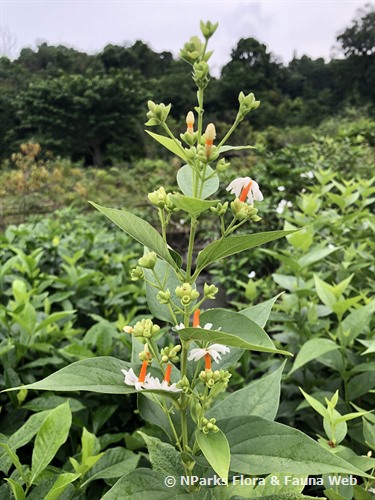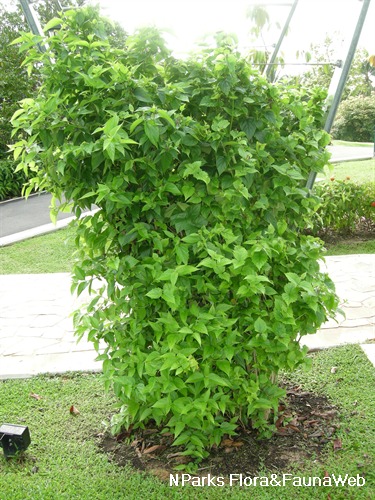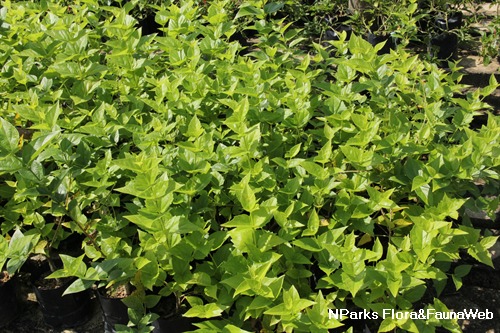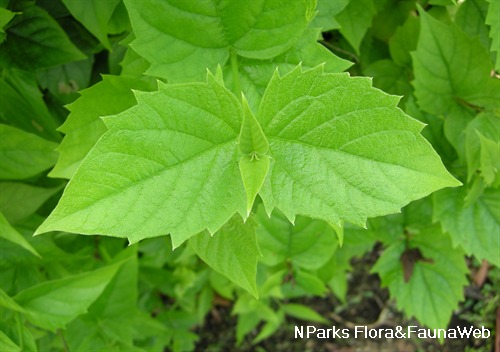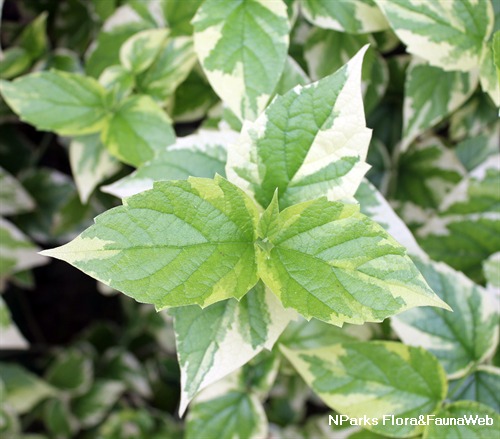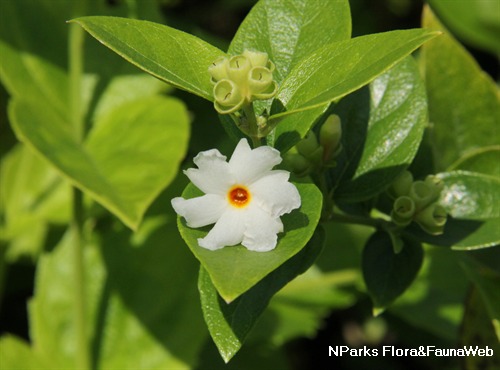
Back
Nyctanthes arbor-tristis
| Family Name: | Oleaceae |
| Common Name: | Tree of Sadness, Seri Gading, Night Blooming Jasmine, Tree of Sorrow, Coral Jasmine |
Name
Classifications and Characteristics
| Plant Division | Angiosperms (Flowering Seed Plants) |
|---|---|
| Plant Growth Form | Shrub, Tree (Small (6m-15m)) |
| Lifespan (in Singapore) | Perennial |
| Mode of Nutrition | Autotrophic |
Biogeography
| Native Distribution | Southern Asia, Pakistan, Nepal, India and Thailand |
|---|---|
| Native Habitat | Terrestrial |
| Local Conservation Status | Non-native |
Description and Ethnobotany
| Growth Form | Large shrub or small tree up to 9 m tall. |
|---|---|
| Trunk | Grey-coloured, rough and flaky bark. |
| Foliage | Hairy and rough green leaves, decussately and simple, margin entire, measuring about 6 - 12 cm long and 2 - 6.5 cm wide. |
| Flowers | Fragrant white flowers, 5 - 8 lobed corolla with an orange-red centre, usually in clusters of 2 - 7 and arranged at the tips of branches terminally or in the axils of leaves. Flowers bloom profusely at night and lose their fragrance and colour as day approaches, and dropping off in the morning. |
| Fruit | Flat, brown, heart-shaped fruit with 2 sections each containing a single seed. |
| Habitat | Usually found on rocky ground in dry hillsides and as undergrowth in dry deciduous forests. |
| Cultivation | This plant can tolerate light shade, but the best growth and most abundant blooming occurs under full sun. It grows best when the soil is watered thoroughly and then allowed to become quite dry before re-watering. Use well-drained soil and a clay pot to help the soil dry faster in order to prevent root rot. Frequent pruning will stimulate this plant to form a dense crown and produce more flowers. Application of a phosphorous rich fertilizer like bone meal will also help to stimulate flowering. |
| Etymology | Genus name Nyctanthes comes from the Greek word "nukto-anqoj", which means night-flower. Species name arbor-tristis means melancholy or sorrowful tree. |
| Ethnobotanical Uses | Medicinal: In the traditional Indian medicine system known as Ayurveda, this plant is used to treat sciatica (leg pain caused by lower back problems) and arthritis. Support for this use was provided by Saxena et al. (1984) who found that the leaf extract has anti-inflammatory activity. Puri et al. (1994) demonstrated that flowers, leaves and especially seeds have compounds that stimulate the immune system. Other studies showed that it has antiviral, anti-fungal and anti-protozoan activity, as well as a protective effect on liver cells. Cultural / Religious: In India, Pakistan, Thailand and Nepal, Coral Jasmine is considered a scared plant and is often planted near monasteries. Others: Flower and leaf extracts contain compounds with mosquito larvicidal activity (Mathew et al. 2009). |
Landscaping Features
| Desirable Plant Features | Ornamental Flowers, Fragrant |
|---|---|
| Landscape Uses | Parks & Gardens, Small Gardens |
Plant Care and Propagation
| Light Preference | Full Sun |
|---|---|
| Water Preference | Moderate Water |
| Plant Growth Rate | Fast to Moderate |
| Rootzone Tolerance | Moist Soils, Well-Drained Soils |
| Pruning | Nyctanthes arbor-tristis can handle hard pruning. It is best to typically remove up to half its growth, but it can also regrow from a small stump. |
| Potential Problems | Avoid overwatering which easily results in root rot. |
| Propagation Method | Stem Cutting |
Foliar
| Foliage Retention | Evergreen |
|---|---|
| Mature Foliage Colour(s) | Green |
| Leaf Area Index (LAI) for Green Plot Ratio | 4.5 (Shrub & Groundcover - Dicot) |
Floral (Angiosperm)
| Flower Colour(s) | White, Orange |
|---|---|
| Flower Texture(s) | Smooth |
| Flower Grouping | Cluster / Inflorescence |
| Flower Location | Axillary, Terminal |
| Flower Symmetry | Radial |
| Individual Flower Shape | Tubular |
Fruit, Seed and Spore
| Mature Fruit Colour(s) | Brown |
|---|---|
| Fruit Classification | Simple Fruit |
| Seed Quantity Per Fruit | Few (1-5) |
Image Repository
Others
| Master ID | 976 |
|---|---|
| Species ID | 2270 |
| Flora Disclaimer | The information in this website has been compiled from reliable sources, such as reference works on medicinal plants. It is not a substitute for medical advice or treatment and NParks does not purport to provide any medical advice. Readers should always consult his/her physician before using or consuming a plant for medicinal purposes. |

